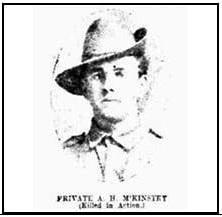Pte
Andrew Hugh McKinstry
Information about birth
|
Year of birth: 1897 |
|
Place of birth: Bendigo, Victoria, Australia |
General information
|
Last known residence: Goornong, Bendigo, Victoria, Australia |
|
Profession: Labourer |
|
Religion: Church of England |
Army information
|
Country: Australia |
|
Force: Australian Imperial Force |
|
Rank: Private |
|
Service number: 5152 |
|
Enlistment date: 11/01/1916 |
|
Enlistment place: Bendigo, Victoria, Australia |
|
Units: — Australian Infantry, 21st Bn. (Victoria) (Last known unit) |
Information about death
|
Date of death: 04/10/1917 |
|
Place of death: Broodseinde, Zonnebeke, Belgium |
|
Cause of death: Killed in action (K.I.A.) |
|
Age: 20 |
Cemetery
|
Tyne Cot Cemetery Plot: XXV Row: D Grave: 22 |
Distinctions and medals 2
|
British War Medal Medal |
|
Victory Medal Medal |
Points of interest 4
| #1 | Place of birth | ||
| #2 | Last known residence | ||
| #3 | Enlistment place | ||
| #4 | Place of death (approximate) |
My story
Andrew Hugh McKinstry was born around 1897. He was the youngest son of William John and Charlotte McKinstry. He lived in Goornong, Victoria in Australia and worked as a labourer. In January 1916, a year after his brother Thomas, he joined the Australian Army at the age of 19. Like his brothers Thomas and James, Andrew was part of the 21st Battalion (6th Brigade, 2nd Australian Division). Their older brother, Arthur, was in the 8th Light Horse Regiment. Both Arthur and James survived the war.
Both Thomas and Andrew were killed on 4 October 1917 at the Battle of Broodseinde, which was part of the Battle of Passchendaele. The attack was preceded by heavy German shelling. At 5.25am, zero hour, the 2nd Australian Division attacked from Zonnebeke. They managed to push through the German artillery shelling and reach the first objective.
During the attack, congestion arose at some pillboxes on the flanks of the ridge. The German artillery had noticed the congestion and fired shells at the pillboxes. The congestion had not escaped the German artillery which lobbed some shells towards the pillboxes. The attack continued unabated. At 7pm, 20 cases of ammunition, 40 jerrycans of water and 10 cases of grenades were delivered. At 20h15, a shell hit Battalion Headquarters, located in a pillbox near the German cemetery on the ridge (28.D.22.d.9.3), igniting 2 cases of ammunition. There were 2 killed and 4 wounded. Headquarters were moved a little to the rear to Deknoet Farm.
On 4 October, 45 were killed, 215 wounded and 15 went missing. Like Thomas, Andrew, only 20, was also one of the dead. After the war, his grave near the German cemetery was recovered (28.D.23.c.30.20) and identified. He was reburied in Tyne Cot Cemetery plot XXV, row D, grave 22.
Both Thomas and Andrew were killed on 4 October 1917 at the Battle of Broodseinde, which was part of the Battle of Passchendaele. The attack was preceded by heavy German shelling. At 5.25am, zero hour, the 2nd Australian Division attacked from Zonnebeke. They managed to push through the German artillery shelling and reach the first objective.
During the attack, congestion arose at some pillboxes on the flanks of the ridge. The German artillery had noticed the congestion and fired shells at the pillboxes. The congestion had not escaped the German artillery which lobbed some shells towards the pillboxes. The attack continued unabated. At 7pm, 20 cases of ammunition, 40 jerrycans of water and 10 cases of grenades were delivered. At 20h15, a shell hit Battalion Headquarters, located in a pillbox near the German cemetery on the ridge (28.D.22.d.9.3), igniting 2 cases of ammunition. There were 2 killed and 4 wounded. Headquarters were moved a little to the rear to Deknoet Farm.
On 4 October, 45 were killed, 215 wounded and 15 went missing. Like Thomas, Andrew, only 20, was also one of the dead. After the war, his grave near the German cemetery was recovered (28.D.23.c.30.20) and identified. He was reburied in Tyne Cot Cemetery plot XXV, row D, grave 22.
Connection to other soldiers 1
|
Thomas Marshall McKinstry
Brother |
Sources 5
|
21st Battalion Australian Infantry, (Australian War Memorial, Campbell (AWM), AWM4 23/38/26). https://www.awm.gov.au Sources used |
|
6th Brigade Australian Infantry, (Australian War Memorial, Campbell (AWM), AWM4 23/6/26). https://www.awm.gov.au Sources used |
|
First Australian Imperial Force Personnel Dossiers, 1914-1920 (National Archives of Australia, Canberra (NAA), B2455). https://recordsearch.naa.gov.au/ Sources used |
|
McCarthy, Chris. Passchendaele: The Day by Day Account (Londen: Arms & Armour Press, 1995), 113. Sources used |
|
Unit embarkation nominal rolls, 1914-18 War (Australian War Memorial, Campbell (AWM), AWM8). https://www.awm.gov.au/ Sources used |
More information 4
|
Commonwealth War Graves Commission Database https://www.cwgc.org/find-records/find-war-dead/casualty-details/463801 |
|
Namenlijst (In Flanders Fields Museum) https://namenlijst.org/publicsearch/#/person/_id=3e21147b-2b5f-4757-9cc2-1ee5ad54ea02 |
|
Lives of the First World War (Imperial War Museum) https://livesofthefirstworldwar.iwm.org.uk/lifestory/7312301 |
|
The AIF Project (UNSW Canberra) https://aif.adfa.edu.au/showPerson?pid=201526 |
